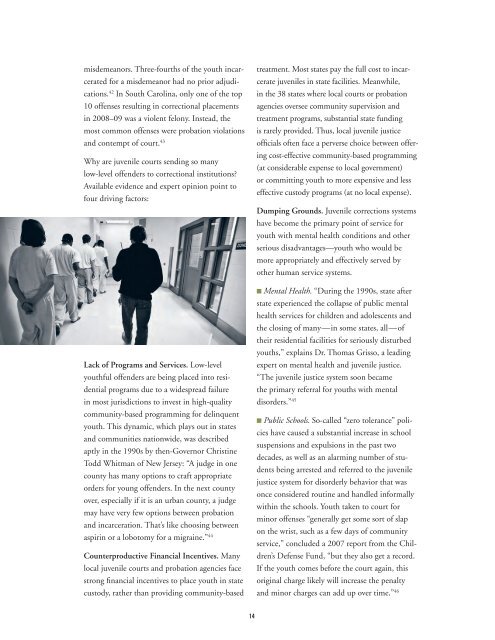misdemeanors. Three-fourths of the youth incarceratedfor a misdemeanor had no prior adjudications.42 In South Carolina, only one of the top10 offenses resulting in correctional placementsin 2008–09 was a violent felony. Instead, themost common offenses were probation violationsand contempt of court. 43Why are juvenile courts sending so manylow-level offenders to correctional institutions?Available evidence and expert opinion point tofour driving factors:Lack of Programs and Services. Low-levelyouthful offenders are being placed into residentialprograms due to a widespread failurein most jurisdictions to invest in high-qualitycommunity-based programming for delinquentyouth. This dynamic, which plays out in statesand communities nationwide, was describedaptly in the 1990s by then-Governor ChristineTodd Whitman of New Jersey: “A judge in onecounty has many options to craft appropriateorders for young offenders. In the next countyover, especially if it is an urban county, a judgemay have very few options between probationand incarceration. That’s like choosing betweenaspirin or a lobotomy for a migraine.” 44Counterproductive Financial Incentives. Manylocal juvenile courts and probation agencies facestrong financial incentives to place youth in statecustody, rather than providing community-basedtreatment. Most states pay the full cost to incarceratejuveniles in state facilities. Meanwhile,in the 38 states where local courts or probationagencies oversee community supervision andtreatment programs, substantial state fundingis rarely provided. Thus, local juvenile justiceofficials often face a perverse choice between offeringcost-effective community-based programming(at considerable expense to local government)or committing youth to more expensive and lesseffective custody programs (at no local expense).Dumping Grounds. Juvenile corrections systemshave become the primary point of service foryouth with mental health conditions and otherserious disadvantages—youth who would bemore appropriately and effectively served byother human service systems.n Mental Health. “During the 1990s, state afterstate experienced the collapse of public mentalhealth services for children and adolescents andthe closing of many—in some states, all—oftheir residential facilities for seriously disturbedyouths,” explains Dr. Thomas Grisso, a leadingexpert on mental health and juvenile justice.“The juvenile justice system soon becamethe primary referral for youths with mentaldisorders.” 45n Public Schools. So-called “zero tolerance” policieshave caused a substantial increase in schoolsuspensions and expulsions in the past twodecades, as well as an alarming number of studentsbeing arrested and referred to the juvenilejustice system for disorderly behavior that wasonce considered routine and handled informallywithin the schools. Youth taken to court forminor offenses “generally get some sort of slapon the wrist, such as a few days of communityservice,” concluded a 2007 report from the Children’sDefense Fund, “but they also get a record.If the youth comes before the court again, thisoriginal charge likely will increase the penaltyand minor charges can add up over time.” 4614
n Child Welfare. Youth involved in the childwelfare system are also at high risk for placementinto juvenile justice facilities. Studies find thatyouth who have been abused or neglected aschildren and become involved in the child welfaresystem are far more likely than other youthto be arrested as juveniles. 47 Once arrested, theseso-called “dual-jurisdiction” youth face exaggeratedrisks both for pre-trial detention and forcommitment into youth corrections facilities orother out-of-home placements. 48Punishing Defiance, Not Delinquency. Manyyouth without serious offending histories areplaced into custody for repeatedly violating rulesand/or behaving disrespectfully toward judges,probation officers, and other authorities. In NewYork City, “markers of institutional complianceand noncompliance”—including probationviolations, prior status offenses, or failure toadmit their crimes and express remorse—arethe “driving forces behind dispositional recommendationsand orders,” a recent study found.“Youth who demonstrate to the court that theycannot or will not obey its orders are identifiedas prime candidates for incarceration.” The studyalso found that “despite the profound impactthat they have on the risk of incarceration, these[markers of institutional non-compliance] arenot very predictive of the risk of recidivism.” 49Nationwide, nearly 12 percent of delinquentyouth in secure correctional custody have beenincarcerated for violating probation or aftercarerules, not for committing new criminal offenses.In some states, the share rises as high as 20 oreven 30 percent, 50 even though many youthconfined on these technical violations have neverbeen adjudicated for a violent or serious offense.Often, the decision to place a youth in a residentialfacility for probation violations or for violatingaftercare rules is made at the sole discretionof a probation or parole officer.Excessive Lengths of Stay. For all of thesereasons, America’s juvenile correctional facilitiesare too often incarcerating the wrong kids…andfor the wrong reasons. However, admissions areonly half the equation that determines the sizeof the confined population. Equally important ishow long these young people remain in custodyonce admitted. Here, too, the signs point towardwidespread excess.Average lengths of stay vary widely from onestate to the next. In its 2009 Yearbook, theCouncil of Juvenile Correctional Administrators(CJCA) reported that the average placementduration for boys was less than six months infour states and more than 18 months in threeothers, while the majority of states reporting datahad average lengths of stay ranging from 6–12months (13 states) or 12–18 months (9 states). 51This wide variation in commitment lengths isinconsistent with the evidence that longer spellsof confinement have either no impact or a counterproductiveimpact on future offending.A recent study of New York City youth releasedfrom juvenile facilities found that, in terms offuture recidivism, “The impact of length of stayis minimal.” A longitudinal study on youth inPhiladelphia and Phoenix found that “There islittle or no marginal benefit, at least in terms ofreducing future rate of offending, for retainingan individual in institutional placement longer.”The analysis found essentially no difference infuture offending for youth held 3–6 monthsvs. 6–9 months, 9–12 months, or more than12 months. 52 A study of youth in Californiayouth facilities in the early 1980s linked longerperiods of juvenile incarceration to heightenedcriminality during adulthood. 53 More recently,a study of youth released from Florida youthcorrections facilities “revealed no consistentrelationship between length of confinement andrecidivism.” 5415



